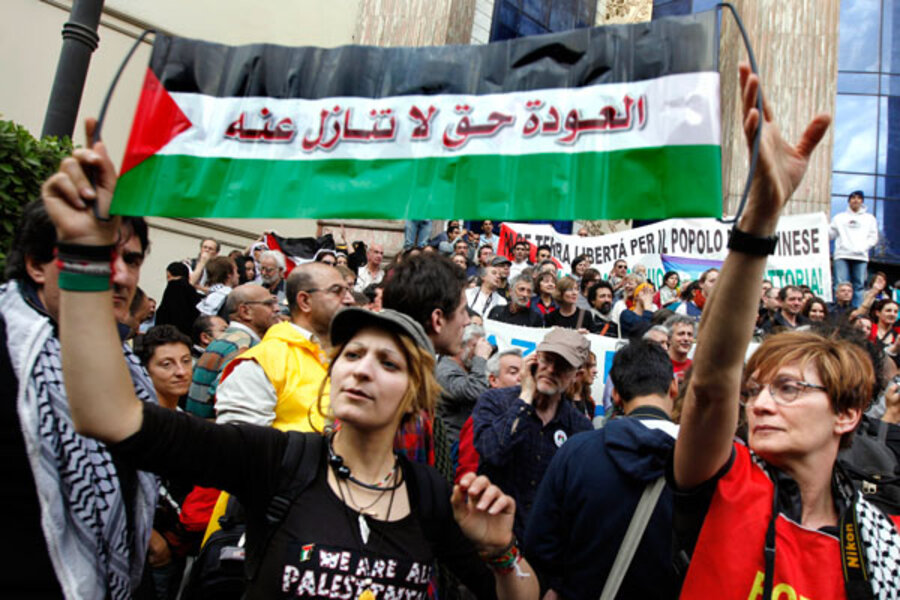Egypt cracks down on foreign protesters heading to Gaza Strip
Loading...
| Cairo
Getting in to the Gaza Strip is no easy feat, but driving across Egypt should not be this hard.
On Sunday, more than 1,000 international activists from 42 countries around the world descended on Cairo to kick off the Gaza Freedom March, a humanitarian convoy and media spectacle organized by US activist group Code Pink.
The plan was to take buses from Cairo to the Egypt-Gaza border post at Rafah, where they would cross in to Gaza to mark the one-year anniversary of the devastating 22-day Israeli campaign against Hamas, which killed more than 1,400 Palestinians and 13 Israeli soldiers.
Organizers say they knew getting into Gaza would be the hard part, so they made sure to check and double check their arrangements with Egyptian authorities. That didn’t stop Egypt from closing the border post and forbidding the activists from driving across the Sinai Peninsula, keeping them from even getting near it.
Much like the humanitarian supplies they were intent on delivering, Gaza Freedom Marchers say they too have been caught in the siege on Gaza. Unable to protest the blockade from within the territory, they have protested it from here. The result has been a tense confrontation between American and European left-wing activism and a repressive police state engaged in a rigorous four-year-long crackdown on critics of the regime of Hosni Mubarak.
Medea Benjamin, an American citizen, cofounder of the antiwar group Code Pink, and one of the march organizers, says she and 50 other US nationals were “beaten up” by Egyptian police when they went to the US Embassy in Cairo to attend a previously scheduled meeting with embassy staff on Tuesday morning.
They went to deliver a letter of support from Sen. John Kerry (D) of Massachusetts, says Ms. Benjamin, but instead were “dragged, pulled, and manhandled” on the pavement by Egyptian police. The group was then detained inside a pen made of metal fences. Benjamin got away and ultimately met with US diplomats, but other protesters were held for six hours.
“The use of force was unbelievable,” she says.
On Sunday, 300 French nationals met at the French Embassy, where they were scheduled to board a chartered bus to drive to the Rafah border post. When they learned that there were no buses, and that Egyptian authorities were barring them from driving past the Sinai town of Al Arish, “we immediately decided to block the street,” says Kauff Alain, a protester from Strasbourg, France.
That street is Sharia Mourad, a major eight-lane thoroughfare in the Cairo district of Giza that is home to the Cairo Zoo, Cairo University, the French and Saudi embassies, and the Four Seasons Hotel, among dozens of other landmarks.
Between 250 and 300 French protesters blocked traffic there for an estimated three hours, turning Giza’s gridlock into an even bigger grind and provoking the wrath of Egyptian police. The protesters were corralled onto the sidewalk in front of their embassy and surrounded by two rows of several hundred baton-wielding riot police who held them there for two days.
“They told us, either you go to the sidewalk in front of your embassy, or we are going to do something to you,” says Loubna Amar, a demonstrator from Lyons, France, who was let out of the makeshift pen on Tuesday morning.
Protesters slept on the sidewalk next to the busy eight-lane road for two days, and say few were allowed to leave to get food or use the toilet. Left with few options, they say all 300 had to use a single bucket on the curb as a bathroom.
“What Egypt has done to us here, this is collective punishment,” says Amar. “We started to call this the Giza Strip.”
So what is next for the Gaza Freedom Marchers? Benjamin says they will march, of course. Or more accurately, walk: “We’re organizing a walk. We’ll go all the way to Rafah.”





